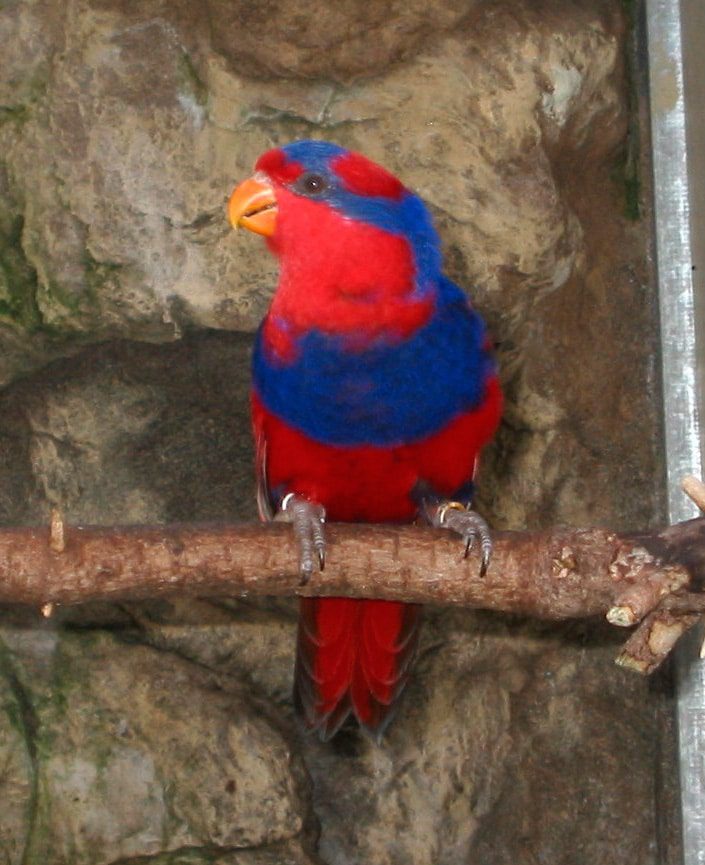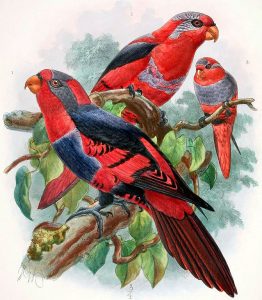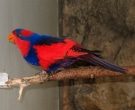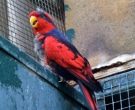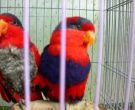Content |
|---|
Description
31 cm.. length and a weight between 150 and 185 gr.
The two main colors of the Red-and-blue Lory (Eos histrio) they are the red and blue.
A broad blue-purple line extends from the eyes through the ears and for the sides of the neck. A broad transverse band blue on the chest. The tail coverts they have blue pink. The feathers of the part superior of the tail they are reddish purple.
The irises is red, the legs grey.
Both sexes are very similar.
In immature, the feathers of the head and the chest they have a dark blue edging. The blue of the crown extends up to the neck and below the eyes. Thighs they are dull purple. The irises They are brown.
- Sound of the Red-and-blue Lory.
Description 3 subspecies
-
Eos histrio challengeri
(Salvadori, 1891) – The band blue of the chest is of smaller size and mixed with red; the blue band of the eyes does not extend to the the mantle; smaller.
-
Eos histrio histrio
(Statius Müller, 1776) – Nominal.
-
Eos histrio talautensis
(Meyer,AB & Wiglesworth, 1894) – More black in the corbeteras wing and in the flight feather.
Habitat:
The Red-and-blue Lory they are common in primary forests, and on the hills of the hills. The feed, they made raids in coconut plantations along the coast and in the more open areas.
They make short trips daily. In the Talaud Islands You can see flying from island to island.
Initially, They lived in large flocks and concentrated in large numbers in common dormitories..
Today, in view of its decline, them find in pairs or in small groups. Large gatherings have become extremely rare or virtually non-existent.
In the Karakelong island were seen, However, on two occasions, more groups of 400 birds.
The Red-and-blue Lory they are birds noisy, which makes them quite easy to observe.
Reproduction:
The species nests in holes in tall trees, most belonging to the class canarium family Burseraceae, and the breeding period main seems to be from May to June, Although it is suspected that nesting may include other months.
We find nests, both in the forests and cultivated areas. The spawning usually includes 2 eggs which are incubated for approximately 25 or 26 days. There is no any other information in the natural environment.
Food:
Although they also consume some insect larvae, the Red-and-blue Lory are mostly vegetarian. They feed on coconut plantations, in the fig trees and trees of the genus canarium It produces edible nuts.
Distribution:
Size of the area of distribution (reproduction / resident): 1,000 km2
The Red-and-blue Lory is confined to the Talaud Islands (almost exclusively in Karakelang) front North of Sulawesi, Indonesian
Description 3 subspecies
-
Eos histrio challengeri
(Salvadori, 1891) – Nanusa Islands, Indonesian. Possibly extinct.
-
Eos histrio histrio
(Statius Müller, 1776) – Sangihe Islands, Indonesian.
-
Eos histrio talautensis
(Meyer,AB & Wiglesworth, 1894) – Talaud Islands, Indonesian.
Conservation:
• Current category of the Red List of the UICN: Endangered.
• Population trend: Decreasing.
This species has a very small range (It is known only in some places), and it is declining due to habitat loss. It has been a downhill fast in the population, largely as a result of their capture for trade, and this is expected to increase in the future. So, qualified as In danger.
Although it was previously abundant, the species has decreased and the population in KarakelongIt was estimated in 8,230-21,400 birds in 1999 (Riley 2003). The subspecies of the nominal of the Sangihe Islands, is likely that has been extinguished.
The encroachment and logging are driving the loss of forests, aggravated by the threat of illegal trade in the species, contribute to the acceleration in the decrease of the population.
In 1999, the investigation concluded that you the 1.000 and 2.000 birds were being captured in Karakelang each year, the 80% (illegally) for the markets of birds of the Philippines.
Ongoing conservation actions:
Since 1995, the project “Action Sampiri” He has been working for the conservation of biodiversity in Sangihe and Talaud, in the implementation of awareness-raising programmes of field work and the conservation and development of ideas for the future use of the land.
Efforts have been made to promote the local support of the species at Talaud, his last bastion.
It has been reported that the poaching and the trade of this species have decreased drastically after the confiscation of assets by Ranger of the forest Department in 2005 (RT Prayudhi in litt., 2008).
The bird is part of the European Association of Zoos, the program Aquaria’s European Endangered [species] and Parrot Taxon Advisory Group (Wilkinson 2000), where it is being bred in captivity (Sweeney, 1998).
"Red-and-blue Lory" in captivity:
It is currently very rare in captivity.
Due to its status in danger of extinction, any specimen that can not be returned to their natural habitat (natural range) should preferably be placed in a well-managed breeding program to ensure the survival of the species.
Alternative names:
– Red-and-blue Lory, Blue-tailed Lory, Red & Blue Lory, Red and Blue Lory, Red-blue Lory (ingles).
– Lori arlequin, Lori histrion (French).
– Harlekinlori (German).
– Lóris-arlequin (Portuguese).
– Lori de las Sangihe, Lori Rojo y Azul (español).
scientific classification:
– Order: Psittaciformes
– Family: Psittaculidae
– Genus: Eos
– Scientific name: Eos histrio
– Citation: (Statius Müller, 1776)
– Protonimo: A player parrot
Images “Red-and-blue Lory”:
——————————————————————————————————-
“Red-and-blue Lory” (Eos histrio)
Sources:
– Avibase, BirdLife.org
– Photos:
1 – En Loro Parque (Spain, Tenerife) by Drägüs – Wikimedia
2 – Lori en Loro Parque, Tenerife, España by Drägüs – Wikimedia
3 – En ZooParc de Beauval, France by User:Edhral – Wikimedia
4 – Red-and-blue lory. two in a cage. by TJ Lin – Wikimedia
5 – A Red-and-blue lory in a zoo by jojo nicdao – Wikimedia
6 – The Red and Blue Lory (Eos histrio now Eos histrio histrio) and The Challenger Lory (EOS challengeri now Eos histrio challengeri) Chromolithograph. Plate VII from A monograph of the lories, or brush-tongued parrots, composing the family Loriidae. By St. George Jackson St. Mivart (1827–1900). Artwork by John Gerard Keulemans (1842-1912). This was published by R. H. Porter (London) in 1896. By John Gerard Keulemans [Public domain], via Wikimedia Commons
– Sounds: Frank Lambert (Xeno-canto)
